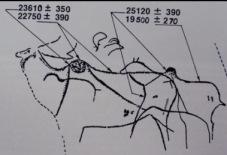Modern humans migrated into Europe around 40,000 years ago. Almost immediately they began decorating cave walls and continued to do so for the next 30,000 years (PIke et al., 2012). Over the course of this period the artwork appears to have undergone an incredible evolution.
The earliest images consist of scratches in the rock or blobs of pigment daubed over the wall. There are some drawings of animals, but they’re generally incomplete outlines. People began to improve, and the animals became increasing common, increasingly coloured and more and more accurate (although they still seem to have had trouble with the feet). This trend of increasing accuracy and colouration continued into later periods, but more importantly they began to draw further back in the cave; often in areas of permanent darkness (Gonzalez and Behrman, 2007).
The final caves are truly a sight to behold. Beautiful, colourful images stretching back along the entire length of a cave; through twisting passages that would never have seen the sun.

The evolution of cave art, from engravings to animals to colourful animals in the dark recesses of caves
Then came the discovery of Chauvet. This French cave was discovered in the ’90s, and seemed to match the final stage of cave art perfectly, with accurate images spread throughout the length of the cave. However, when these paintings were radiocarbon dated the results suggested that Chauvet was in fact around 36,000 years old. This would make them some of the oldest drawings in Europe, even though they seemed to fit right on the end of the evolutionary scale (Valladas et al., 2001).

One of the panels in Chauvet cave, showing the unique way the artists “layered” animals on top of each other
However, dating cave art is a tricky thing. Only a handful of images are suitable for dating, and even then prehistoric people may have used old materials to draw them, making them seem older than they actually are.

A piece of cave art which appears to have multiple dates, showing how tricky it can be to figure out how hold it is
Cosquer cave, for example, contains sticks of charcoal ranging from 15 – 27,000 years old. Someone may have started off drawing with a younger stick, run out and used one they found on the floor that was much older. This can also result in images that appear to have different lines drawn at different dates, thousands of years apart. Either prehistoric people were very persistent, or there’s something fishy going on (Bednarik, 1996).
As a result of these issues the dates of Chauvet were doubted by most for many years. The matter was finally resolved when it was found that the cave was sealed by a rockslide around 21,000 years ago, several thousand years before the art in Chauvet supposadly “evolved.” Dating rockslides is a lot easier than dating cave art, so this seemed to be the end of the matter (Sadier et al., 2012). Chauvet was definitely older than it should be, given the traditional model of cave art evolution. The first Europeans were as good at drawing as those at the end of the stone age.
That said, many cave sites continue to match the predictions of the traditional model. A study published last year examined the dates of 50 pieces of Spanish artwork, and showed that were all the correct age (Pike et al., 2012). When the results of all dated cave sites are looked at together roughly half are consistent with the model (Gonzalez and Behrman, 2007). This is a higher rate than chance, but is it enough to justify claims about how cave art evolved over time?

Some of the artwork dated in the recent Spanish study
To some the existence of just one counterexample is enough to refute the model of cave art evolution. After all, a single example of a human living alongside a dinosaur would prove fundamentally challenging to biological evolution, why not the same for art evolution? And we don’t just have the one example, there are many caves that aren’t the age they should be.
Whilst there may be some grain of truth to the idea, it would seem that the idea cave art gradually increased in complexity is wrong. The first Europeans had the same capabilities as those who came later and could draw just as well. On reflection this discovery doesn’t seem too surprising. After all, those who arrived in Europe were the same biologically and intellectually as later artists, including us.
It seems silly to suggest it took us 20,000 years to figure out how to draw feet on animals.
References
Bednarik, R. 1996. Only time will tell: A review of the methodology of direct rock art dating. Archaeometry, 38(1):1-13
González, J. J. A., & Behrmann, R. D. B. (2007). C< sup> 14</sup> et style: La chronologie de l’art pariétal à l’heure actuelle. L’Anthropologie, 111(4), 435-466.
Pike, A. W., Hoffmann, D. L., García-Diez, M., Pettitt, P. B., Alcolea, J., De Balbin, R., … & Zilhão, J. (2012). U-series dating of Paleolithic art in 11 caves in Spain. Science, 336(6087), 1409-1413.
Sadier, B., Delannoy, J. J., Benedetti, L., Bourlès, D. L., Jaillet, S., Geneste, J. M., … & Arnold, M. (2012). Further constraints on the Chauvet cave artwork elaboration. Proceedings of the National Academy of Sciences, 109(21), 8002-8006.
Valladas, H., Clottes, J., Geneste, J. M., Garcia, M. A., Arnold, M., Cachier, H., & Tisnérat-Laborde, N. (2001). Palaeolithic paintings: evolution of prehistoric cave art. Nature, 413(6855), 479-479.

